Sekiro, From Software's next game, subverts nearly everything we've come to expect from Dark Souls
For every system that From Software strips away, there's is one that is completely new.
When I watched Sekiro's debut during Microsoft's press conference at E3 2018, I knew this was going to be a different kind of Dark Souls. The Japanese setting, the comparatively bright environments, and a flippin' grappling hook were all obvious clues. But I still made the assumption that Sekiro would just be another riff on the same formula. If Bloodborne was the metal cover song of Dark Souls, then surely Sekiro was just the traditional Japanese cover?
I couldn't have been more wrong. A lengthy demo of Sekiro I watched on Monday made me realize From Software's new game boils away so much of Dark Souls' cherished design that the two could scarcely feel more different. And yes, that's a good thing. Here's everything you need to know.
The biggest changes
For every idea Sekiro: Shadows Die Twice strips away from the Dark Souls formula, a new one is introduced.
Sekiro: Shadows Die Twice is not an RPG. There are no stats to level up and no armor or weapons—except for gadgets I'll get to later—to collect and equip. There are no classes to choose from. There is no multiplayer of any kind. You'll have no souls to reclaim after dying, and—from the looks of it—no checkpoint bonfires to kindle.
For the Dark Souls diehards, that list of have nots might be terrifying to read. But for every idea Sekiro: Shadows Die Twice strips away from the Dark Souls formula, a new one is introduced.
Set in 1500s Sengoku-era Japan, you play as an unnamed shinobi charged with protecting a young lord with a mystical lineage. Then a powerful samurai attacks, kidnapping the lord and lopping off your arm (Sekiro translates to "one-armed wolf"). You're left for dead, but as the title implies, it doesn't stick.
In the same way that Dark Souls and Bloodborne reimagined medieval and Victorian time periods, Sekiro is a reimagining of medieval Japan—but one that feels more rooted in history. Most of the enemies we encountered in the demo were human warriors, a big change from Souls' undead and Bloodborne's blood-crazed wolfmen.
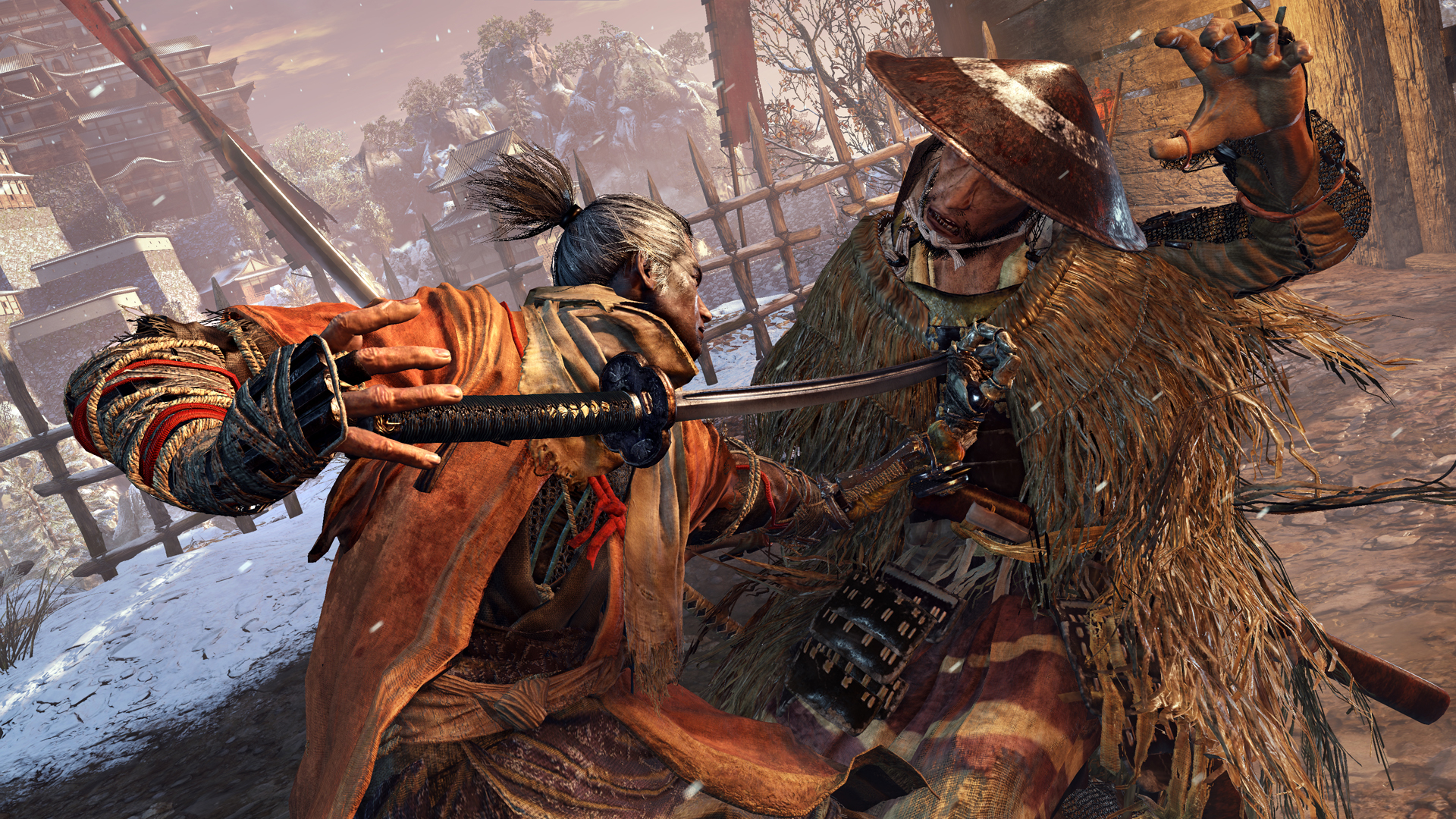
As I said, Sekiro is not an RPG. From Software's Yasuhiro Kitao describes it as an action adventure game, making it sound more akin to Zelda where exploration will yield new items that help you progress. You won't be making your own character or leveling up stats, but you will be finding all manner of cool gadgets that attach to your 'Shinobi Prosthetic' that replaces your lost hand. If you liked how Bloodborne's weapons transformed into wildly different types, you'll probably love this new system.
The biggest gaming news, reviews and hardware deals
Keep up to date with the most important stories and the best deals, as picked by the PC Gamer team.
The character always wields the same katana in his right hand, but his left hand can swap between a ton of tools that have offensive and utilitarian uses. An axe, for example, might help you destroy enemy shields. The demo showcased a Shinobi Firecracker, which could stun enemies, as well as a torch addon that could set them alight. There's also a shield that can block damage.
These tools will combo with your sword attacks in surprising ways. During the demo, the player thrust his katana through his torch-arm, igniting it so each swing would deal fire damage.
Then, of course, comes the grappling hook. Environments in Sekiro are designed with verticality in mind, and you're free to use your grappling hook to leap onto cliffs, rooftops, and more. From what I saw, the grappling hook feels natural to use and isn't locked down to specific grapple points. It even has uses in combat, like pulling enemies in or using it to get behind an enemy for a deadly slash.
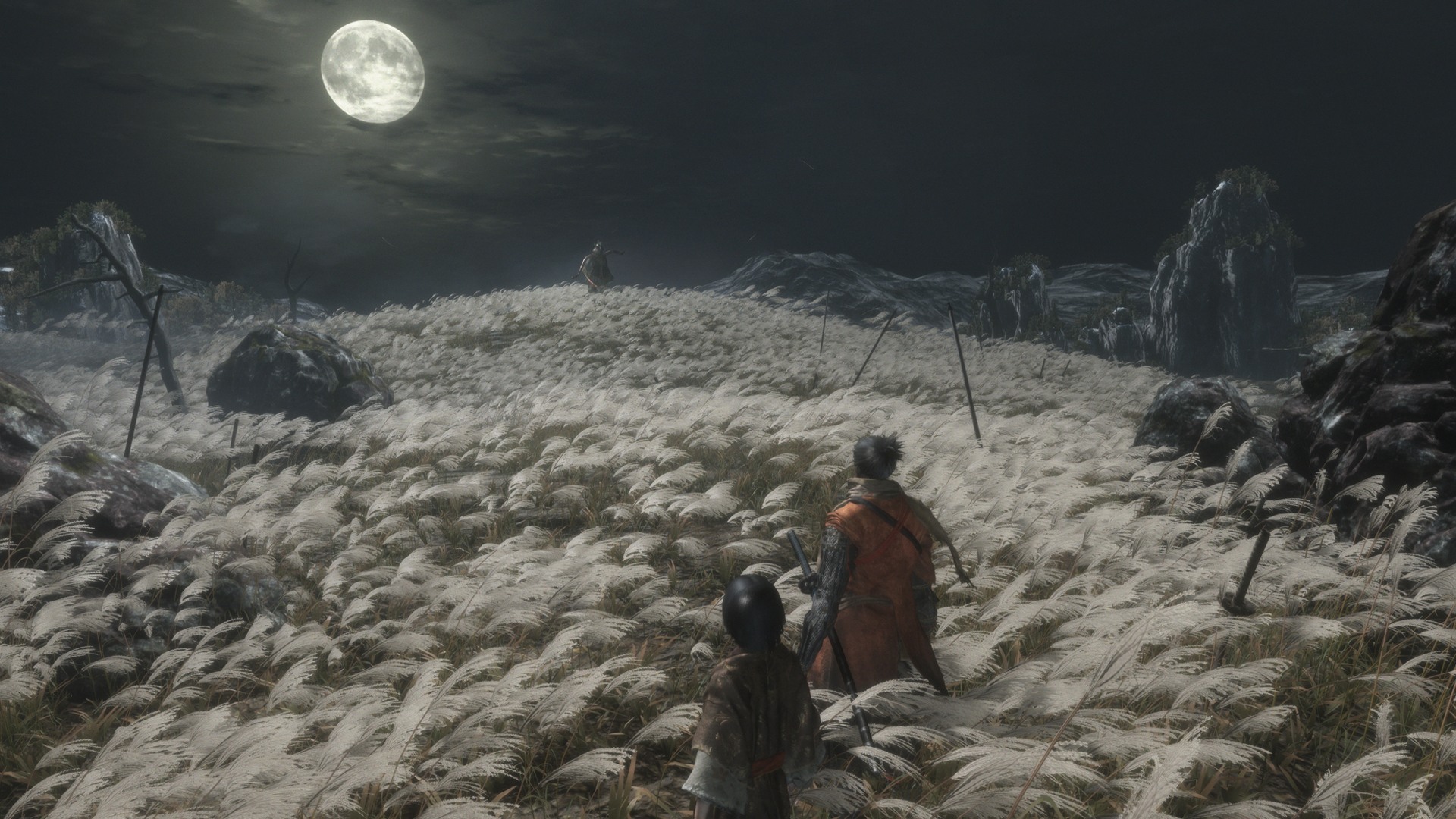
The combat
While Kitao was unwilling to give too many specifics on combat systems, I can safely say that Sekiro is unlike anything we've seen in other From Software games. Instead of hacking away at an enemy's health bar, Kitao says famed director Hidetaka Miyazaki wanted to capture the feel of "swords clashing."
While there's still HP, combat revolves around 'posture.' When you attack an enemy, they'll easily block your attack but will lose posture each time. Once lowered enough, they'll be open to a gory finishing move, but the same goes for you. As enemies attack, blocking lowers your posture unless you block perfectly (similar to parrying in Dark Souls). With a perfect block you'll actually throw the enemy off balance and lower their posture instead.
In this way, combat in Sekiro feels more authentic to a sword duel: A battle of attrition as each tries desperately to create an opening to deliver a fatal strike. Once you finally trip a foe up enough, you can hit them with a 'Shinobi Death Blow'—a gleefully bloody finisher that kills weaker enemies instantly.
Yup, Sekiro has a dedicated jump button.
There's a ton to unpack here, though. Your Shinobi Prosthetic plays an obvious role, as attachments like the axe can shatter a shield and leave an enemy vulnerable. But what really caught me off guard were Kanji symbols that would appear above the player's head. I was told that these symbols have different functions, but a common one was the Kanji character for danger. When it appeared, it signaled the enemy was about to deliver a special attack.
Knowing what that special attack is and how you can avoid it, however, requires reading their animations. Like any traditional enemy, you'll come to memorize different patterns of attack. But there's additional wrinkles here. Some enemies, I'm told, will use sweep attacks to knock you down that cannot be blocked. The only way to avoid them is by using—get this—the jump button. Yup, Sekiro has a dedicated jump button.
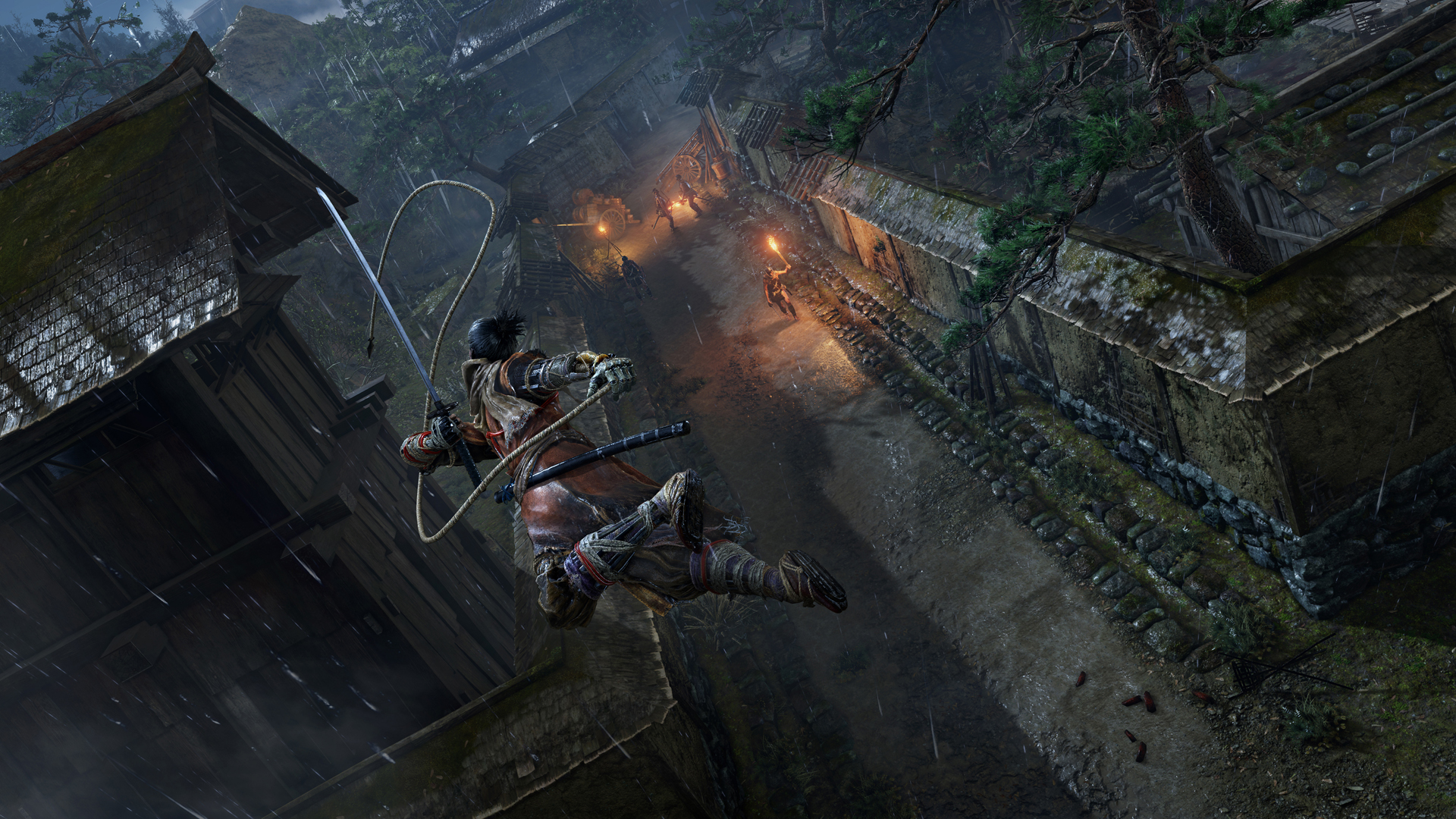
Sekiro also has "light stealth mechanics." Instantly fatal stealth kills on enemies can help even the odds. You can press up against walls, hang off of ledges, and crouch in grass to stay hidden. If anyone wanders too close, you can finish them off Assassin's Creed style.
What's great about this is how it changes the approach to combat. Instead of facing most enemies head-on like you would in Dark Souls (or cheesing the hell out of them if you're a wimp like me), Sekiro's stealth and more open environments play to all sorts of strategies. In one encounter, the shinobi killed off an enemy sniper and then leapt onto a trailing guard, turning what should have been a five versus one fight into a much more approachable three on one.
In one scene, an old woman came creeping through a building we were hiding in. I was told that if she spotted us, she'd alert the guards. So we slit her throat instead. Sekiro is definitely a stealth game—and grim as hell, too.
This all comes together in boss battles, which look more challenging than ever. Near the end of the demo, we were ambushed by the Corrupted Monk, a terrifyingly large woman with a naginata. True to Dark Souls, she came at us with an agile barrage of attacks that, with the help of the Kanji characters appearing above our heads, could be predicted and dodged or blocked.
Seeing how the katana and Shinobi Prosthetic comboed together with the grappling hook, jumps, and blocks made combat feel even more aggressive and fatal than Bloodborne's. The bridge we dueled on was covered in cherry blossom petals that billowed in response to each attack, turning the fight into a mesmerizing dance.
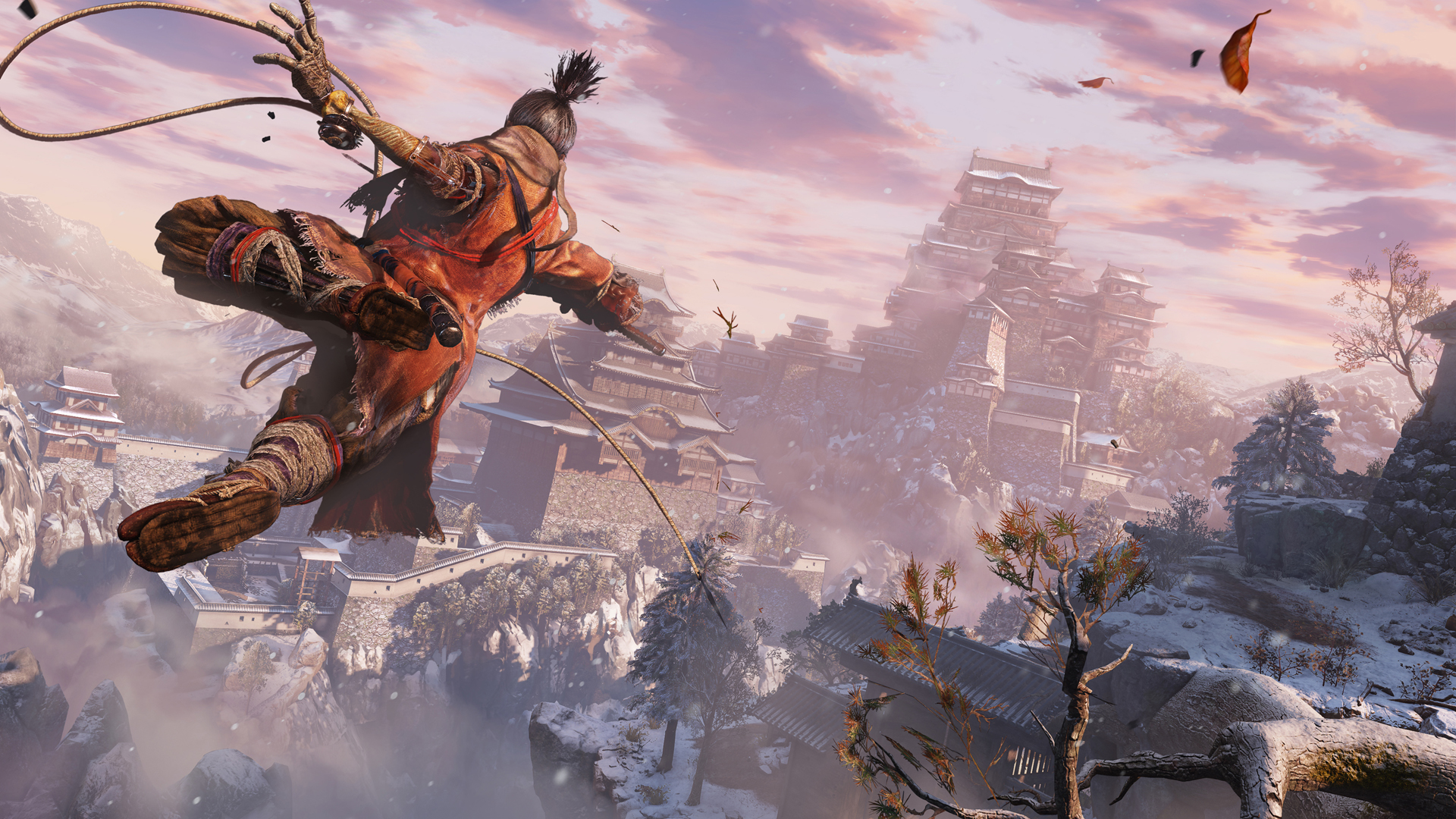
So, what happens when you die?
When you die you can revive yourself and immediately jump back into combat.
It's hard not to want to read into the "Shadows Die Twice" part of Sekiro's name. From Software wasn't willing to explain it in depth, but there is an entirely new death system at play here. Instead of restarting at a checkpoint, when you die you can revive yourself and immediately jump back into combat. The crazy part: as soon as you die your enemies will lose interest in you and go back to what they were doing. This turns death "into an opportunity" to surprise enemies by reviving when they don't expect it and getting in a few instakills.
Hardcore fans might balk at this system since it seems to make Sekiro much easier. Kitao said there was a limit to how many times you could revive in combat, but wouldn't clarify more than that.
A whole new world
Similar to Dark Souls, Sekiro will feature an expansive, interconnected world that you can explore at will. It's not clear how diverse this world will feel, though, considering the one area we saw felt like a fairly typical Japanese village with a castle towering in the distance. It's certainly a more subtle look compared to Bloodborne's gothic aesthetic, but no less beautiful.
And it's no less fantastical, either. While a good many enemies were typical soldiers, there was one weird giant (who appeared in the trailer) that was obviously into wrestling considering his passion for pile-driving the player into the ground. We also saw the enormous, mountain-sized snake that appeared at the end of the announcement trailer as we tried navigating through a canyon.
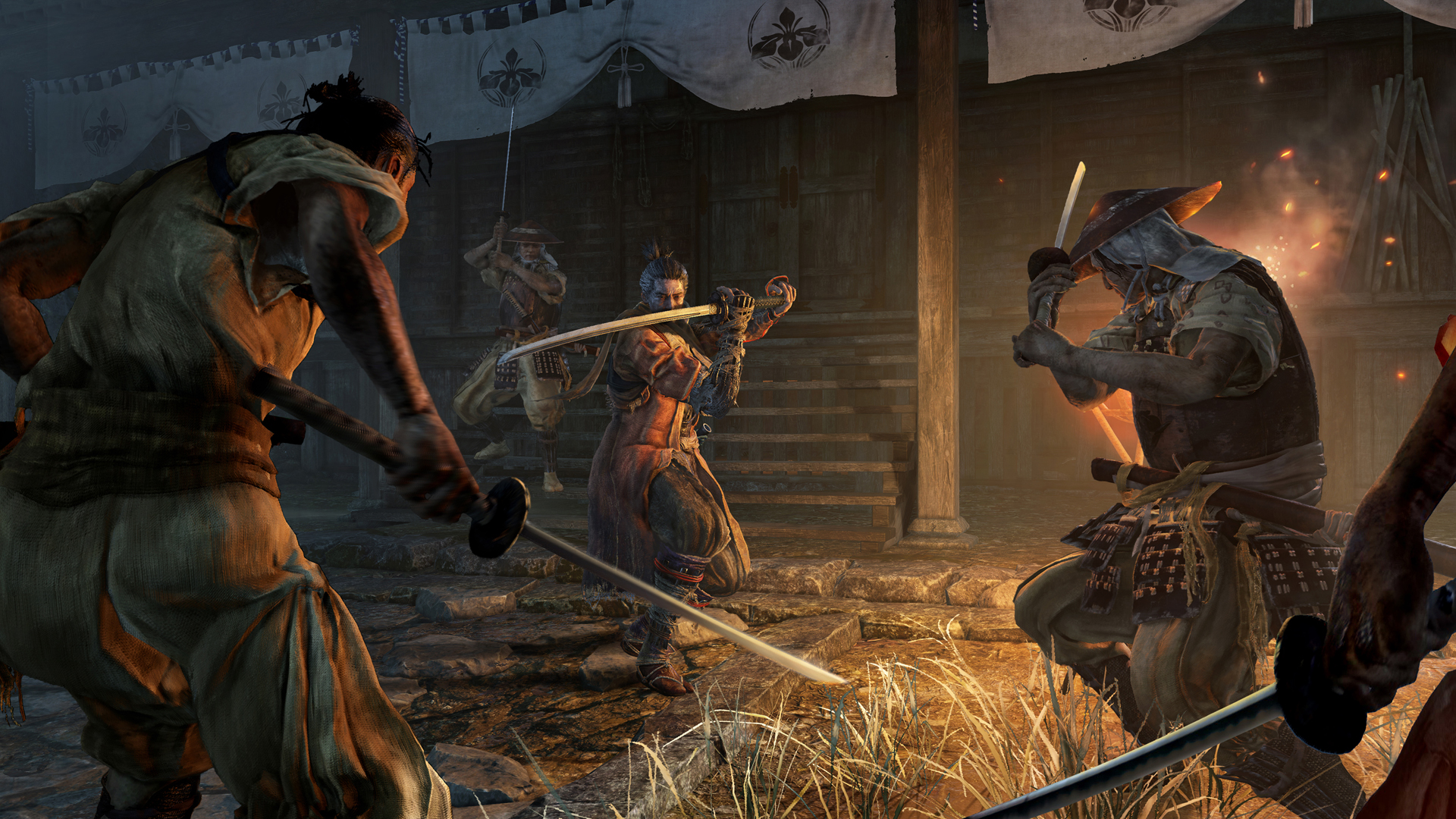
This is not Dark Souls: Japan, but something new and altogether uncharted.
Though the sequence involving the snake was cut short for time, Kitao explained that there'd be many scenes that involve "cat and mouse" games with incomprehensibly large monsters. In this particular demo, the player had to wait for moments when the snake wasn't looking make his move to traverse the canyon. I get the sense that these encounters won't be like traditional boss fights, but are more like environmental puzzles that have to be figured out. But then again, Dark Souls' infamous bridge dragon appeared that way, too, until some insane player stuck a hundred arrows in him and realized his tail could be cut off for a sword.
Speaking of swords, I already mentioned that there will be no traditional equipment system in Sekiro. Instead, new Shinobi Prosthetic attachments are found by exploring the world. I did ask if there was any kind of currency system like souls or blood echoes, and was told that there was, but it was different. From Software wasn't ready to talk about it too much. While Kitao wanted to affirm that this was not an RPG, the currency system will work with some kind of upgrade system for your gear.
There are moments where it feels hard to wrap my head around just how different Sekiro is to From Software's other games, and moments where it feels the exact same. I love that the animation for opening grand, weighty doors hasn't changed in nearly a decade. It's little details like these that pay homage to Sekiro's lineage, even if so much is new and different.
And ultimately, I think that's a good thing. I love that From Software isn't content to repeat the same formula in a different location. This is not Dark Souls: Japan, but something new and altogether uncharted. And that deep, gripping sense of mystery is what made Dark Souls so compelling in the first place. Sekiro: Shadows Die Twice is coming early next year.
With over 7 years of experience with in-depth feature reporting, Steven's mission is to chronicle the fascinating ways that games intersect our lives. Whether it's colossal in-game wars in an MMO, or long-haul truckers who turn to games to protect them from the loneliness of the open road, Steven tries to unearth PC gaming's greatest untold stories. His love of PC gaming started extremely early. Without money to spend, he spent an entire day watching the progress bar on a 25mb download of the Heroes of Might and Magic 2 demo that he then played for at least a hundred hours. It was a good demo.


